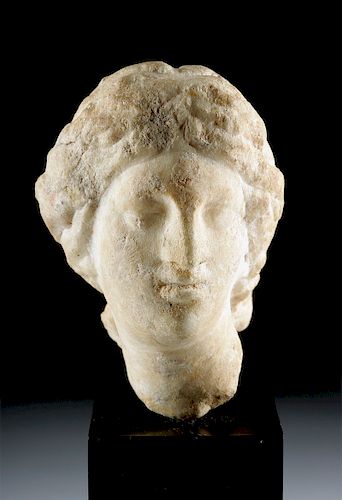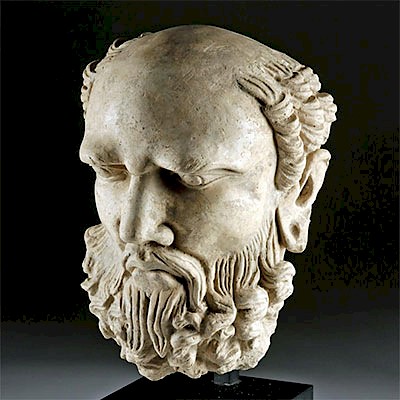Greek Hellenistic Marble Female Head - Aphrodite
Lot 66
About Seller
Artemis Fine Arts
686 S Taylor Ave, Ste 106
Louisville, CO 80027
United States
Selling antiquities, ancient and ethnographic art online since 1993, Artemis Gallery specializes in Classical Antiquities (Egyptian, Greek, Roman, Near Eastern), Asian, Pre-Columbian, African / Tribal / Oceanographic art. Our extensive inventory includes pottery, stone, metal, wood, glass and textil...Read more
Categories
Estimate:
$6,500 - $9,750
Absentee vs Live bid
Two ways to bid:
- Leave a max absentee bid and the platform will bid on your behalf up to your maximum bid during the live auction.
- Bid live during the auction and your bids will be submitted real-time to the auctioneer.
Bid Increments
| Price | Bid Increment |
|---|---|
| $0 | $25 |
| $300 | $50 |
| $1,000 | $100 |
| $2,000 | $250 |
| $5,000 | $500 |
| $10,000 | $1,000 |
| $20,000 | $2,500 |
| $50,000 | $5,000 |
| $100,000 | $10,000 |
| $200,000 | $20,000 |
About Auction
By Artemis Fine Arts
Jan 16, 2020
Set Reminder
2020-01-16 10:00:00
2020-01-16 10:00:00
America/New_York
Bidsquare
Bidsquare : Ancient | Asian | Ethnographic
https://www.bidsquare.com/auctions/artemis-gallery/ancient-asian-ethnographic-4799
Featuring classical antiquities, ancient and ethnographic art from cultures encompassing the globe. Artemis Fine Arts info@artemisfinearts.com
Featuring classical antiquities, ancient and ethnographic art from cultures encompassing the globe. Artemis Fine Arts info@artemisfinearts.com
- Lot Description
Greece, Hellenistic, ca. 4th to 3rd century BCE. Carved in the round, a lovely marble head of a female, perhaps Aphrodite, the goddess of love and beauty, depicted with her head turned slightly toward the right, carved with beautiful facial features and a wavy, centrally-parted, upswept coiffure - bound in a bow-shaped chignon over the nape of her neck. The goddess' elegant, oval face is sensitively modeled so as to present a naturalistic visage characteristic of the Hellenistic period with a rounded forehead, large and generously lidded almond-shaped eyes, a fine brow line that rises gracefully at the center and merges with the bridge of her nose, a soft rounded chin, and full, bow-shaped lips. Truly life-like, despite the goddess' mythical status, this naturalistic visage demonstrates that the sculptor was virtuosic in his ability to bring marble to life! Size: 4.125" H (10.5 cm); 8" H (20.3 cm) on included custom stand.
Aphrodite's sublime beauty legendarily inspired much rivalry among the gods, not to mention countless depictions throughout art history, among the most famous, the Renaissance artist Sandro Botticelli's "Birth of Venus" (1484-86), Baroque artist Peter Paul Rubens' "Judgement of Paris" (ca. 1636), and of course, Attic sculptor Praxiteles's "Aphrodite of Knidos" (ca. 360-330 BCE) and the equally famous "Lely's Venus" (ca. 100 to 199 CE).
Provenance: private East Coast, USA collection; ex-William Froelich, New York and California in the US and Saba in the Caribbean, purchased by Mr. Froelich in the 1970s
All items legal to buy/sell under U.S. Statute covering cultural patrimony Code 2600, CHAPTER 14, and are guaranteed to be as described or your money back.
A Certificate of Authenticity will accompany all winning bids.
We ship worldwide and handle all shipping in-house for your convenience.
#141467Old losses to neck line and lower peripheries of coiffure. Normal surface wear with abrasions in areas. Scattered mineral deposits. Feint striations at back of coiffure, on one side of chignon is a long inclusion/vein in the stone, on the other side is a fissure.Condition
- Shipping Info
-
All shipping is handled in-house for your convenience. Your invoice from Artemis Gallery will include shipping calculation instructions. If in doubt, please inquire BEFORE bidding for estimated shipping costs for individual items.
-
- Buyer's Premium



 EUR
EUR CAD
CAD AUD
AUD GBP
GBP MXN
MXN HKD
HKD CNY
CNY MYR
MYR SEK
SEK SGD
SGD CHF
CHF THB
THB














